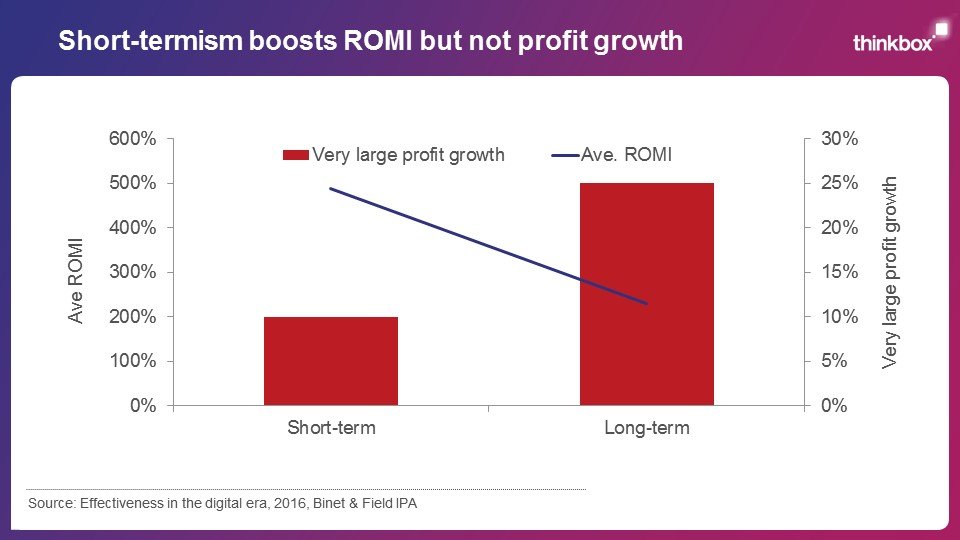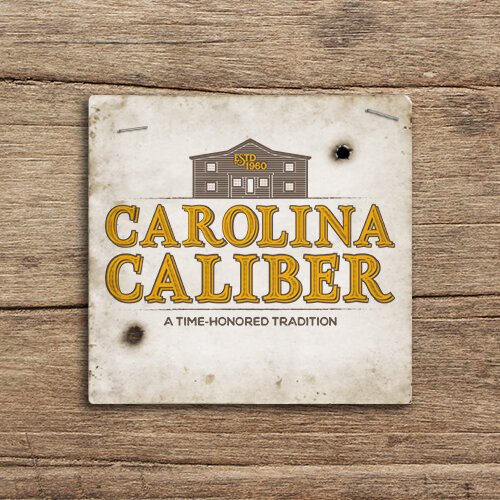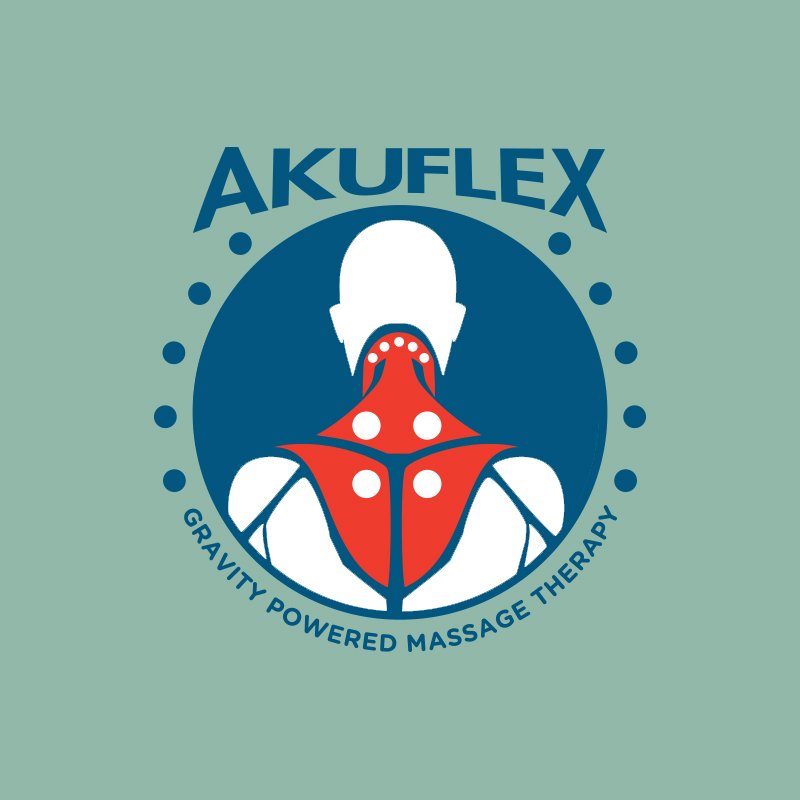The way most agencies practice “demand generation” doesn’t actually generate much demand – if any at all. At best it converts existing demand into sales more efficiently. Some call it sales activation or sales conversion. We like to call it what it was originally called – direct response marketing. Instead of Yellow Pages, direct mail, classifieds and call centers, today’s direct response marketing combines old school techniques with martech. Email, SEO, SEM, paid social and pay per click banners drive in-market prospects (those who have indicated in some way or form they have an intention to buy) to landing pages and e-commerce sites with the explicit objective to get them to buy now.
Even though these direct response tactics are not so good at generating demand, they tend to be very efficient at harvesting it. They are usually inexpensive to produce and can be measured and tracked. Results are pretty immediate (6 months or less) and ROI tends to be good because they segment and target prospects who are in the category market, are aware of the problem the category solves and are actively looking for and need a solution. No wonder the entire industry has shifted from marketing to direct response marketing - what’s not to like?
Plenty.
For the same reasons the top brands didn’t invest the majority of their marketing budgets into direct response marketing tactics 20 years ago neither should you now.
Let’s start with one of the biggest culprits - ROI.
Ads targeting in-market prospects who are ready and looking to buy, can and should deliver a higher ROI. Duh. They simply don’t have to work as hard as ads targeting people who are out of market (people not ready and not searching to buy). Add in brand familiarity and you quickly see why email and good ol’ direct mail deliver higher ROIs. In fact, a study by McKinsey and Company found that email outperforms social media by a factor of 40x! Turns out it’s much easier to get in-market buyers with some brand familiarity to buy than someone who isn’t ready to buy and has never heard of your product or service. Makes total sense.
So why don’t you just invest 100% of your ad budget into email? Well, for starters, your sales would eventually dry up except from a small percentage of heavy buyers. Almost immediately, you’d start seeing diminishing returns with each new blast. As prospect needs are fulfilled by you and/or other brands and they move out of market, your sales will shrink but your ROI may actually rise as your list dwindles down to only your most loyal buyers. Plus you’ll start to annoy the crap out of those who aren’t ready to buy. In other words, you’ll get good short-term results and ROI but very bad, business-destroying long-term ones.
Short-term, direct response advertising tactics make Returns On Marketing Investment (ROMI) more efficient. HOWEVER, these tactics do not increase profit growth.
This is why any advertising strategy focused on maximizing ROI is doomed to eventually hit a wall and fail. The tactics that produce the biggest short-term ROI do not generate demand - they harvest existing demand. They do not grow awareness and consideration they just make converting the converted easier and faster. They do not build brands, grow awareness, consideration or create any long-term brand value over time.
They destroy them.
Below are a few ROI-maximizing direct response marketing tactics. Each has the goal of converting prospects to buyers now. They are all focused on reaching segmented and hyper-targeted audiences of in-market prospects. They are all short-term, measurable by the minute, have small or no production costs, are forgettable, logic-driven, on low-attention platforms, have a strong call to action and provide almost zero long-term benefits. Once you stop running them, sales drop to zero.
Email Promotions and Newsletters
Database Marketing
Direct Mail Letters & Postcards
Direct Response Advertising (Social Media, Display Ads, Print, Radio, TV, Newspapers)
Telemarketing
Leaflets
Brochures
Catalogues
Direct Selling
Push Notifications Via Installed Apps
SMS or Text Messaging
SEO
Google Adwords
Financing/APR Ads
Sale/Discount Ads
Retargeting Ads
Influencer Marketing
Affiliate Marketing
Coupons
Discount Codes
Financing Ads
PPC
Brochure
E-Commerce Site
Webinars
See the problem?
What percentage of your marketing budget goes into the above? If you’re like the vast majority of marketers, you’re probably spending way over 50% on some or all of them. A recent WARC survey of more than 1,350 marketers worldwide found that half plan to increase spend on sales activation, direct response advertising. Fewer than one in three intends to invest more in brand building campaigns, down from a rate of two in five in 2021. In fact many companies dedicate 70 – 100% of their budgets to direct response tactics. Unless you are in the launch phase of a start-up or have a very small serviceable market, this is the exact opposite of what you should be doing.
Bear with me a bit longer. I promise I’ll get to what really generates demand soon. But first, I need to give you just a bit more context.
A recent study by the Ehrenberg-Bass Institute confirmed a very interesting statistic regarding in-market buyers:
The percentage of in-market prospects who are ready, willing and able to buy any product or service in any category at any time is only 5%.
In other words, 95% of your prospective buyers are not ready to buy at any given time. Which means all the money and time that goes into the direct response marketing tactics above are always chasing an elusive 5% of the category market. The Ehrenberg-Bass Institute calls this the 95:5 Rule. And get this, around 70% of that 5% will choose a brand they know or are at least familiar with. So if you’re not a well-known brand in your category, you’re SOL. You’ll be forced to duke it out with other lesser known brands for the remaining 30% of that 5%. And that’s not even taking into account fake clicks and faulty intent data various platforms use to segment and target your audience.
Most of the third-party intent data that pretty much everyone uses is highly inaccurate. A study by Deloitte found that only 29% of the data on of consumers they researched was more than 50% accurate. Which means many of the potential buyers your ads target will not actually be in-market.
In summary, there is nothing that stunts growth (demand) more than hyper-targeting the smallest, most competitive segment of "high-value," in-market buyers who are at the very end of their buying process. Better ROI is not the KPI you should be chasing because doing so will only lead to more hyper-targeting which will increase ROI, which will lead to even more hyper-targeting and segmentation…and so on and so on. As Peter Drucker said,
“You have to produce results in the short-term. But you have to produce results in the long-term, too. And the long-term is not simply the adding up of short-terms.”
In other words, a series of successful short-term ad campaigns does not build long-term success. That’s because real demand generation grows future sales. Short-term, highly targeted, direct response targets do not. Real growth is dependent upon growing future sales tomorrow - not harvesting them today. In their ‘Effectiveness in Context’ paper, advertising effectiveness researchers Les Binet and Peter Field conclude,“there is no context in which short-term sales activation is the primary driver of growth.”
Growth comes from expanding your market of potential buyers, not shrinking it. You simply can’t achieve growth by stalking the same hyper-targeted segments your competitors are after with bargain-basement ROI-focused tactics. To grow, you have to reach both buyers and non-buyers. People who are in-market and ready to buy now and those who are out of market and not ready to buy today but could be buyers in the future. If you aren’t known to buyers before they purchase, stalking and chasing an ever-decreasing pool of them around the internet in the final hours before they buy while vying for their attention against your rivals is futile.
Ok, now that we’ve beat that dead horse to a pulp here it is…
THE WORLD’S GREATEST DEMAND GENERATOR
The secret to long-term, sustainable growth is to invest the majority of your marketing and spending efforts into getting your brand into one, single place. You need to permanently embed your brand in the absolute best and most underutilized search engine of all time – the human brain.
The most underutilized and most powerful search engine in the world is the human brain. Putting your brand here is the ultimate product placement and demand generator.
The key to any successful demand-generating strategy is to find and define your Higher Business Purpose.
HOW TO GET IN YOUR CUSTOMERS’ HEADS AND STAY THERE
STEP 1: FIND THE BEST DOORWAY INTO YOUR CUSTOMERS’ MINDS
For every brand, product and service there is a unique doorway that will provide the best access into their potential consumers’ minds. At the heart of this doorway is how you position your brand against your rivals. We call this your Higher Business Purpose. (Not to be confused with the term Higher Purpose that some agencies use to describe how businesses can make the world a better place through environmental sustainability, social justice or some other popular cause not directly related to business growth.)
A clearly articulated Higher Business Purpose is the most important strategic deliverable your agency can give you. It’s a brand positioning statement on steroids.
We define your Higher Business Purpose as the one thing your business can deliver more profitably to your category of customers that they really want and need which your competitors can’t or won’t. In essence it synthesizes all the learning about your business, your competitors and your customers into a powerful statement that acts like a brand promise and value proposition with super powers.
It will serve as your company’s North Star. It will guide the creation of your mission, vision, and core values. It will inspire the development of your Brand Platform and Integrated Brand Marketing Communications Plan - key message, support points, core values, audience description, core customer entry points (CEPs), long and short-term business objectives, media plan, customer service, pricing, distribution, product innovations and extensions, sales and operations, etc., etc. Most importantly, it will serve as a decision filter to help you choose what and what not to do to deliver on your promise over and over again and grow.
Warning. Seek the help of a professional on this one. To see a few Higher Business Purpose statements we’ve written click here.
The eyes have it. Your advertising is worthless if it fails to attract attention. Period.
STEP 2: GET NOTICED
The best brand positioning strategy, creative brief and communications plan are all worthless if your communications fail to get noticed. That means every single piece of communication that you create should be impossible to ignore. Each should be designed and written to maximize attention – from your logo to your biz card to your website to your advertising.
Make sure your brand logo, font, colors, tagline and tone of voice are easily recognizable and look and sound as different as possible from your competitors. Having distinctive brand assets will not only set you apart and help you grab more attention; they will also help you become more recognizable and memorable.
A few distinctive logos we’ve created.
An estimated 84% of advertising is ignored – so just being noticed gives you a huge advantage. That’s why the first objective of any should be to grab as much attention as possible. Instead of being afraid your ads won’t be liked, be very afraid it won’t be noticed. Data from The Long & Short Of It by Les Binet & Peter Field shows that aiming for fame – making more people notice, remember and become familiar with your brand – can massively enhance revenue and growth.
Here’s a simple standard we set for all our communications. Make sure it is the most interesting, entertaining or informative thing in the physical environment or on the media channel in which appears - or start over.
READ MORE: THE RULES OF ATTRACTION
STEP 3: GET IN THEIR HEADS
Being impossible to ignore and maximizing attention won’t help you much if you’re brand is not remembered. Therefore, the second priority of every piece of communication you create is to make sure it is hard to forget. As we like to say, be impossible to ignore and hard to forget.
The name of the game is fame. Ads rarely generate immediate sales. The best ads generate memories tied directly to the brand. Memories generate demand, search and sales.
You can’t generate demand for your product or service if they can’t remember your name and what you do. Success isn’t about who you know – it’s who knows you.
It takes 5 -7 impressions for people to remember an average brand. A great ad can reduce that number to just one or two impressions. The goal for any brand in any category should be to become the first brand people think of when a need for a product or service it fulfills arises. If your product or service is not in the top three most recalled brand names in your category you’re leaving big money on the table. Remember, when given a choice, people will choose brands they are familiar with 70% of the time. What’s more brand memorability drives search - not vice versa. Because Nike’s advertising has made their running and basketball shoes famous, people who want them search for Nike running shoes or Air Jordans not running shoes or basketball shoes. Bottom line, the efforts you put into making your brand stick in peoples’ memories will pay off big time.
Brands with highly creative ad campaigns that grab more attention and are more memorable - win. In fact, an ad’s creativity is proven to be the biggest driver of sales.
The more creative your advertising the more likely it will be noticed, shared, remembered and grow sales.
The world’s most memorable advertising campaigns are:
Highly creative, entertaining and surprising
Built around single idea and key message that is consistently refreshed in unexpected ways (Think Dos Equis’ The Most Interesting Man In The World or GEICO’s “15 minutes could save you 15% or more on car insurance”)
Consistently branded (this is where those distinctive brand assets come in)
Have a memorable tagline that summarizes the key promise or message (Nike’s Just Do It, Dos Equis’ Be Thirsty My Friend, BMW’s The Ultimate Driving Machine, Snickers’ You’re Not Yourself When You’re Hungry, etc.
Reminders of Key Buying Opportunities or Customer Entry Points (CEPs) that clearly link the brand to core situations that trigger purchase. Caution one per ad works best. More on CEPs below.
Ad campaigns built around a central creative idea with a single key message that’s refreshed over and over again in surprising ways are 57% more effective than those that are not.
STEP 4: GET IN MORE HEADS THAN YOUR COMPETITORS
Maximizing creativity is the key to being impossible to ignore and hard to forget. But even the most attention-grabbing and memorable communications in the world cannot generate enough sales if they don’t reach enough people. And no, you can’t make your advertising go viral. It either happens or it doesn’t. As someone who’s created multiple viral hits seen by hundreds of millions of people - trust me, the odds are stacked way against you. It’s also tougher today than it was five years ago. Online media platforms want your money. For the most part, reach is strictly pay to play today. Secondly, even if it goes viral, it probably won’t reach enough of your target.
So what do you do? Through paid, earned and owned media you try to reach as many people in your addressable market as possible. Market penetration is 3X more likely to be the main driver of company growth when they focus on acquiring new customers instead of increasing sales from existing customers.
As Professor Byron Sharp demonstrated in How Brands Grow and reaffirmed in a recent study by the IPA, advertising campaigns that target the entire market of buyers deliver the biggest positive business and brand effects. These include increased profits, customer acquisition and retention, strengthened pricing, brand memorability, short-term sales growth, long-term market share growth.
Broad reaching campaigns that target the entire category market, produce more very large, positive business and brand effects from advertising than those with narrower targets.
Follow the 95:5 Rule. Research from the Ehrenberg-Bass Institute, concludes the percentage of people who are in-market and ready to buy any product or service in any category at any given time is only around 5%. The other 95% are out of market. This adds another important reason why you should expand the reach of your communications to as many people in your category as possible – not just those in-market.
Smart marketers focus on reaching the 95% of buyers who are out of market. This dramatically increases the probability their brands will come to mind first when buyers enter the market and are ready to buy. Instead of hyper-targeting the 5%, broadly target the 5% and the 95%.
Target the category and reach all potential buyers.
STEP 5: STAY IN THEIR HEADS
Once you get your demand generation campaign going, don’t stop. To maximize results, you need to be in it for the long-term. Short-term campaigns are considered to be 6 months or less. Long-term, brand-building, demand generating campaigns need to last at least 12-months but the biggest gains don’t usually happen until after 18 months. Even longer if the buying cycle is longer. This goes back to the fact only 5% of your market is in-market and ready to buy at any given time. And even though you’ll be reaching and growing consideration with lots of new potential buyers, it just takes time for them go from out of market to in-market. So stick with it and quit assessing performance with ROI. It’s almost always going to be lower than your more short-term tactics targeting a much smaller group of in-market buyers. Here’s the results you’ll likely see if you invest no less than 60% of your budget in a long-term brand building, demand generating campaign and no more than 40% in a direct response, demand harvesting campaign.
If you stop investing in long-term, brand-building, demand generating campaigns you’ll start to see a gradual erosion of results over time.
Over time, you’ll want to refresh your campaign. We’ve already discussed the importance of being consistent yet surprising with your key message and branding to increase memorability. You should also expand the number of communications channels your advertising runs on. Instead of just running ads on one channel like social media, you should objectively look at other channels like print, TV, outdoor, YouTube, radio, etc. If you’re only running ads on one or two media channels, you’re leaving money on the table. A massive study by the Advertising Research Foundation concluded that each additional channel a campaign runs on increases sales. Five channel campaigns are ideal with a 35% more incremental sales than one channel campaigns. What’s more, seeing a brand advertised on different media channels engages long-term memorability.
If at all possible, integrate your advertising across 5 different platforms for maximum memorability and saIes lift.
The other thing you’re going to want to do to increase reach and memorability is to utilize Customer Entry Points (CEPs) in your advertising. CEPs or Key Buying Occasions, as we like to call them, are situations that trigger a buyer to need your product or service. Advertising the CEP that’s most relevant and unique to your brand will help buyers link your brand to that particular need situation. So when that particular need situation arises they’re more likely to think of your brand. The more CEPs your brand is known for, the more likely it will get purchased and the more likely existing customers will continue to purchase it. Here’s a list of questions you can ask your customers to find out what your core CEPs are. Caution: Focus on only one CEP per ad. Adding more will probably create confusion.
A list of questions that will help you figure out your key buying Occasions.
Utilizing CEPs is also a great way to expand your target market, reach and even break into another category. Instead of focusing on one situation your brand can be used for, incorporate other situations and target new segments with them. For example if you sell a center console fishing boat, the most obvious CEP to show would be saltwater fishing. Those ads would target coastal fishermen. Another CEP would be to show inshore fishing – then you could target fishermen who live on the coast and in land-locked states with lakes. You could expand further by showing the boats being used for a couple’s sunset cruise or pulling kids on a tube. Each of those situations would require new ads and an expanded reach.
And there it is ladies and gentlemen, the five steps to generate real demand. It’s not easy. It’s not quick. And it’s not cheap. However, the companies that stick with it will most likely grow faster, bigger and more profitably. They will weather economic downturns better, make higher margins and be way more likely to be chosen over rival brands. And of course, there’s much I’ve left out of each step that we only share with our clients.
A FEW MORE IMPORTANT TIPS
So what are you going to do with all that new demand you generate? Well, that’s where direct response advertising comes in. To maximize conversions, you need to run a separate but identically branded campaign to harvest all that new demand. But, if you’re like most companies, you probably already know how to do that.
To maximize results, run two campaigns simultaneously. One that generates demand through brand building and one that harvests demand through sales activation.
THE 60/40 RULE
When you invest 60% or more of your budget in a brand building, demand generating campaign and 40% or less in a demand harvesting, sales activation campaign, here’s what your results should look like over time. The direct response, sales activation campaign will deliver sales in the short-term but will not grow demand or sales in the long-term. Your brand-building, demands generating campaign will deliver sales in the short and long-term but will deliver bigger growth and profits over the long-term.
We’d be honored to help you generate more demand. To find out how we can help, email Immortology with a request for an introductory call here.
NOTE:
Most of the insights included in this report are not mine. I have liberally stolen them from my favorite marketing heroes including Les Binet, Peter Field, Mark Ritson, Professor Byron Sharp, Jeni Romaniuk, Tom Roach, Dr. Grace Kite, Bob Hoffman and Professor John Dawes. Their big, giant marketing brains are helping smaller, feebler marketing minds like my own grasp and implement more effective marketing approaches. The research is not mine either. I’ve pilfered most of the charts and graphs from marketing’s greatest evidence-based research organizations including the Ehrenberg-Bass Institute, WARC, IPA, ThinkBox, Deloitte, The B2B Institute, Advertising Research Foundation, Nielsen and McKinsey & Company. Together these brilliant organizations and individuals are shining a light upon the entire marketing industry and holding us all to a higher and proven standard of real effectiveness. If you’re truly interested in the latest evidence-based marketing solutions, I highly recommend you follow them all.























